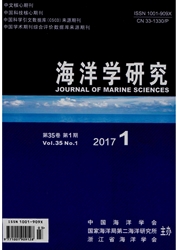

 中文摘要:
中文摘要:
沉积记录中的古环境信息,是经过各种复杂的生物地球化学过程改造后的信号,因而是不完整的,有些甚至可能是被歪曲的。通过表层沉积有机碳、生物硅和色素对上层海洋的响应,对南海古生产力替代指标的可靠性及其影响因素作出初步评估。尽管南海海洋生产力较低,生源通量以小颗粒为主(沉降速率慢),侧向漂移明显,且不易形成低氧条件,使有机碳的保存效率比较低,影响了沉积有机碳作为古生产力替代指标的可靠性,但南海表层沉积有机碳含量在大的时空尺度上仍然能反映上升流高生产力区状况,说明沉积记录(几十至几百年时间尺度)对小尺度(自季至年)上的"细节"差异可以进行"平滑"。总的来说,沉积有机碳是比较好的古生产力指标,但对于寡营养、生物群落结构时空变化大、碳酸盐溶解和陆源稀释影响明显的南海,将绿素和生物硅含量作为古生产力替代指标时应该更加慎重。
 英文摘要:
英文摘要:
The water column processes and preservation of biogenic components largely determines the possibility and credibility of utilizing geochemical indicators as paleo-environment proxies. In this paper, we presented organic carbon, opal and chlorine data of surface sediments to check if these parameters are significant or not to be sued as indicators of paleo-production (PP). Due to lower primary production and faster turnover rate in deep waters, the biological pump efficiency in the SCS was relative low. The stronger upper ocean advection leads to horizontal transportation of particulate matter. These factors as well as selective decomposition of organic matter during settling and sedimentation would affect reliability of some bulk PP proxies. Comparisons between sedimentary organic carbon, chlorine and opal, and the upwelling area and upper layer production indicate that organic carbon is a good paleo-PP, but chlorine and opal are not because sedimentary biogenic component is strongly affected by carbonate dissolution and lithogenic dilution in this oligotrophic, low PP marginal sea. Exceptions may be found in areas with a relative shallow water depth, stable sedimentation rate and good organic matter preservation, where chlorine and opal could also be used as good paleo-PP proxies.
 同期刊论文项目
同期刊论文项目
 同项目期刊论文
同项目期刊论文
 期刊信息
期刊信息
